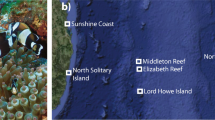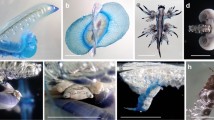Abstract
The ecological performance of the sea anemone Heteractis magnifica was examined during a 36-month experiment with respect to season and the presence and numbers of a mutualist (orange-fin anemonefish Amphiprion chrysopterus). Anemones primarily grew during the autumn, with most asexual reproduction occurring in winter; mortality was not strongly seasonal. Individual growth rates did not differ between anemones harboring one or two anemonefish, but these rates were three times faster than for anemones lacking Amphiprion. Anemones with two anemonefish had the highest fission rate, whereas those without anemonefish had the lowest. By contrast, anemones that were not defended by anemonefish suffered higher-than-expected mortality. As a consequence, anemones with two Amphiprion had the greatest net increase in surface area, and those lacking anemonefish had a negligible gain that was statistically indistinguishable from zero after three years. Anemonefish not only enhanced anemone survivorship as previously believed, they also fostered faster growth and more frequent asexual reproduction.





Similar content being viewed by others
References
Bronstein JL (1994) Our current understanding of mutualism. Q Rev Biol 69:31–51
Bruno JF, Stachowicz JJ, Bertness MD (2003) Inclusion of facilitation into ecological theory. Trends Ecol Evol 18:119–125
Fautin D (1991) The anemonefish symbiosis: what is known and what is not. Symbiosis 10:23–46
Fautin D, Allen GR (1997) Anemone fishes and their host sea anemones. Western Australian Museum, Perth, 160 p
Fricke HW (1974) Öko-Ethologie des monogamen Anemonenfisches Amphriprion bicinctus (Freiwasseruntersuchung aus dem Roten Meer). Z Tierpsychol 36:429–512
Fricke HW (1975) Selektives Feinderkennen bei dem Anemonenfisch Amphiprion bicinctus (Rüppell). J Exp Mar Biol Ecol 19:1–7
Godwin J, Fautin DG (1992) Defense of host actinians by anemonefishes. Copeia 1992:902–908
Gotto RV (1969) Marine animals, partnerships and other associations. American Elsevier, New York
Holbrook SJ, Schmitt RJ (2002) Competition for shelter space causes density-dependent predation mortality in damselfishes. Ecology 83:2855–2868
Holbrook SJ, Schmitt RJ (2004) Population dynamics of a damselfish: effects of a competitor that also is an indirect mutualist. Ecology 85:979–985
Liberman T, Genin A, Loya Y (1995) Effects on growth and reproduction of the coral Stylophora pistillata by the mutualistic damselfish Dascyllus marginatus. Mar Biol 121:741–746
Mariscal RN (1970a) A field and laboratory study of the symbiotic behavior of fishes and sea anemones from the tropical Indo-Pacific. U Calif Publ Zool 91:1–43
Mariscal RN (1970b) The nature of the symbiosis between Indo-Pacific anemone fishes and sea anemones. Mar Biol 6:58–65
Meyer JL, Schultz ET (1985a) Migrating haemulid fishes as a source of nutrients and organic matter on coral reefs. Limnol Oceanogr 30:146–156
Meyer JL, Schultz ET (1985b) Tissue condition and growth rate of corals associated with schooling fish. Limnol Oceanogr 30:157–166
Mitchell JS (2003) Mobility of Stichodactyla gigantea sea anemones and implications for resident false anemonefish, Amphiprion ocellaris. Environ Biol Fish 66:85–90
Mokady O, Loya Y, Lazar B (1998) Ammonium contribution from boring bivalves to their coral host—a mutualistic symbiosis? Mar Ecol–Prog Ser 169:295–301
Moyer JT (1980) Influence of temperate waters on the behavior of the tropical anemonefish Amphiprion clarkii at Miyake-jima, Japan. B Mar Sci 30:261–272
Muscatine L (1974) Endosymbiosis of cnidarians and algae. In: Muscatine L, Lenhoff HM (eds) Coelenterate biology, reviews and new perspectives. Academic, New York, pp 359–395
Roberts JM, Davies PS, Fixter LM (1999) Symbiotic anemones can grow when starved: nitrogen budget for Anemonia viridis in ammonium-supplemented seawater. Mar Biol 133:29–35
Ross RM (1978) Territorial behavior and ecology of the anemonefish Amphiprion melanopus on Guam. Z Tierpsychol 46:71–83
Schmitt RJ, Holbrook SJ (1996) Local-scale patterns of larval settlement in a planktivorous damselfish - do they predict recruitment? Mar Freshwater Res 47:449–463
Schmitt RJ, Holbrook SJ (2000) Habitat-limited recruitment of coral reef damselfish. Ecology 81:3479–3494
Schmitt RJ, Holbrook SJ (2003) Mutualism can mediate competition and promote coexistence. Ecol Lett 6:898–902
Sokal RR, Rohlf FJ (1995) Biometry. WH Freeman and Co, New York, 887 p
Spotte S (1996) Supply of regenerated nitrogen to sea anemones by their symbiotic shrimp. J Exp Mar Biol Ecol 198:27–36
Stachowicz JJ (2001) Mutualism, facilitation, and the structure of ecological communities. Bioscience 51:235–246
Acknowledgements
We thank K. Seydel for assistance in the field and A. Brooks and A. Thompson for discussion. We gratefully acknowledge the support of the National Science Foundation (OCE 99-10677) and the W.M. Keck Foundation. This is contribution No. 90 of the UC Berkeley Gump Research Station.
Author information
Authors and Affiliations
Corresponding author
Additional information
Communicated by Biological Editor K.S. Sealey
Rights and permissions
About this article
Cite this article
Holbrook, S.J., Schmitt, R.J. Growth, reproduction and survival of a tropical sea anemone (Actiniaria): benefits of hosting anemonefish. Coral Reefs 24, 67–73 (2005). https://doi.org/10.1007/s00338-004-0432-8
Received:
Accepted:
Published:
Issue Date:
DOI: https://doi.org/10.1007/s00338-004-0432-8




